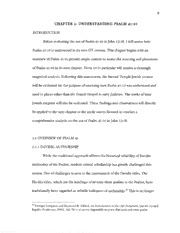
Jesus as the righteous sufferer in the betrayal of Judas: understanding the use of Psalm 41:10 in John 13:18 PDF
Preview Jesus as the righteous sufferer in the betrayal of Judas: understanding the use of Psalm 41:10 in John 13:18
V ABSTRACT This study examines how the evangelist understood and used Psalm 41:10 in his own context inJohn 13:18. The evangelist's textual representation of Psalm 41:10 is noticeably different from the way the LXX translates Psalm 41:10. This observation calls to attention the primary task of this study: What is the rationale for the evangelist's unique textual representation of Psalm 41:10 inJohn 13:18? The author of this study argues that the presence of this textual uniqueness in the Fourth Gospel is best explained through the assessment of the evangelist's hermeneutical and theological understanding of Psalm 41:10. For this assessment, the author evaluates the possible reasons for the evangelist's intentional employment of certain interpretive and exegetical techniques. Based on these observations, the author concludes that in the betrayal of Judas, the evangelist seeks to portray Jesus as a Davidic figure who fulfills the pattern of the righteous sufferer. This was hermeneutically, theologically, and thereby textually significant for the evangelist.
